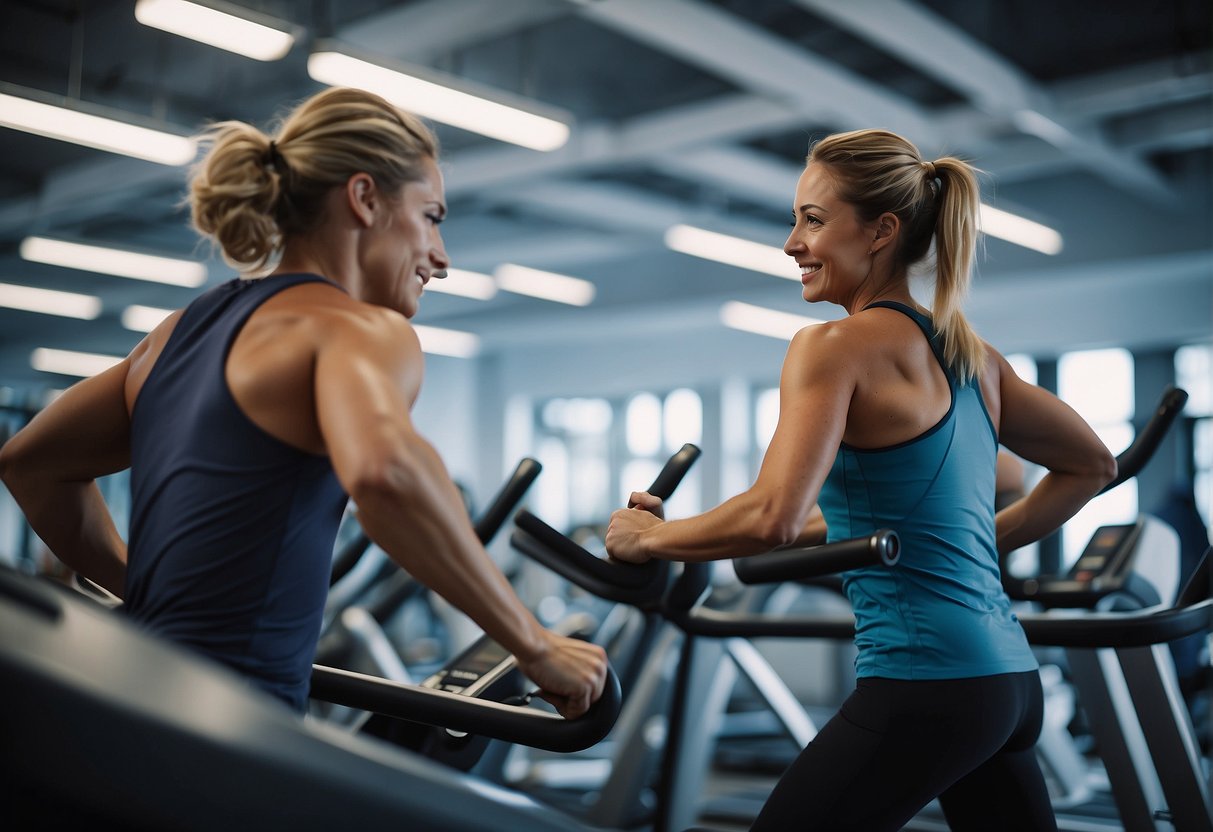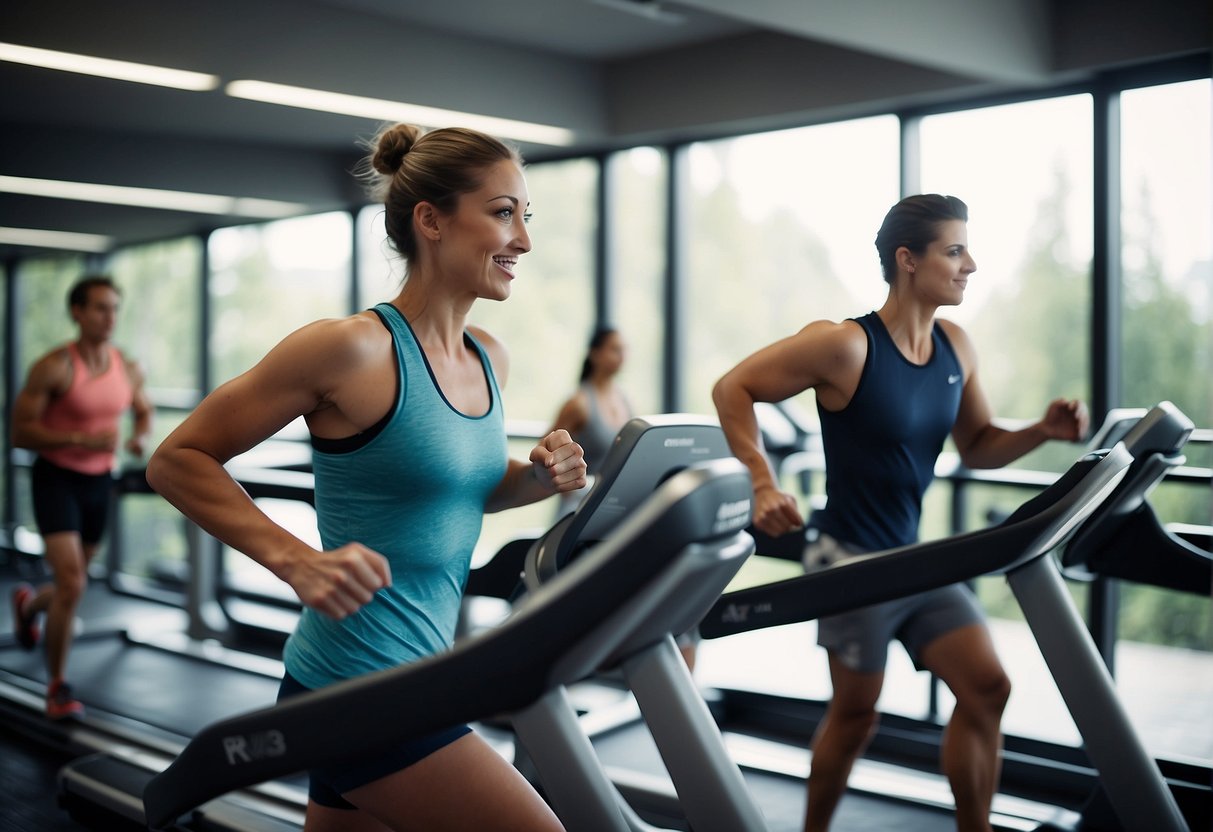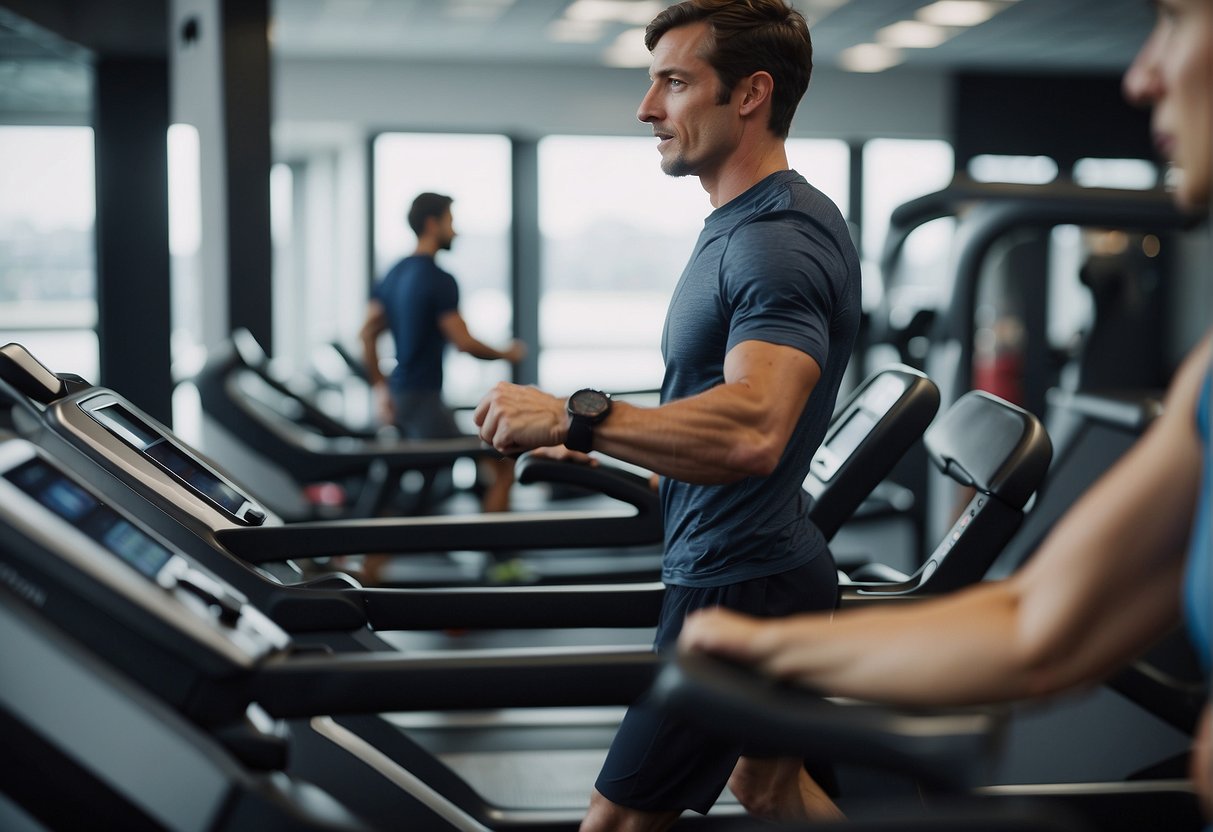When considering the addition of cardio equipment to a home gym, it can be challenging to choose between a treadmill and a rowing machine. Both pieces of equipment offer unique benefits and can be instrumental in achieving various fitness goals.
Treadmills are renowned for their ability to provide a high-intensity cardiovascular workout, emulating natural walking or running motions, which can be particularly appealing for those aiming to improve their aerobic fitness or pursue weight loss.

Conversely, rowing machines offer a comprehensive workout that engages multiple muscle groups simultaneously. While also providing substantial cardiovascular benefits, rowers place significant emphasis on muscular strength and endurance. They are ideal for those looking to increase overall body strength in addition to enhancing their cardio fitness.
Furthermore, the rowing motion is low-impact and can be kinder on the joints compared to the repetitive impact of running, which is an important consideration for individuals with joint issues or those seeking a lower-impact exercise option.
Key Takeaways
- Both treadmills and rowing machines serve as effective tools for cardiovascular workouts and cater to different fitness goals.
- Rowing machines target a broader range of muscle groups and offer low-impact exercise, reducing the risk of joint injury.
- Practical considerations such as space, cost, and individual fitness levels are crucial when choosing the right equipment for your home gym.
Comparing Treadmills and Rowing Machines

When we look at cardio equipment, two popular choices are treadmills and rowing machines. Each offers unique benefits and challenges, so let's compare their key features.
Treadmills are a staple in gyms and homes, known for simulating walking, jogging, or running. They're excellent for improving cardiovascular health, burning calories, and building lower body strength. Since treadmills offer a familiar exercise, they're often more approachable for beginners.
On the other hand, rowing machines provide a full-body workout, engaging both the upper and lower body. They're particularly effective for building back muscles and improving overall endurance. Here, the resistance can usually be adjusted, suiting a variety of fitness levels.
| Treadmills | Rowing Machines |
|---|---|
| Primarily lower body workout. | Full-body workout. |
| Adjustable incline to simulate uphill running. | Adjustable resistance to increase intensity. |
| Typically larger and require more space. | Generally more compact and easier to store. |
| High impact, which may affect joints. | Low impact, offering a smoother motion. |
We recommend you review the rowing machine comparison on Start Rowing for a concise breakdown. For insights into the rowing machine's simplicity, head over to Live Science.
Ultimately, our choice between the two depends on our fitness goals, space considerations, and personal preference for workout style. It's essential to try both and see which feels right for us.
Cardiovascular Benefits of Treadmills and Rowers

When we consider cardiovascular training, both the rowing machine and the treadmill prove to be exceptional choices for enhancing our cardiovascular system. Each offers unique advantages in aerobic workouts, which are pivotal for heart health.
Impact on Cardiovascular System
Rowing machines provide a full-body workout, engaging several major muscle groups that contribute to cardiovascular fitness. When we row, our hearts must pump more efficiently to supply blood to the active muscles. This action can improve the strength and endurance of our hearts over time. Rowing is known for being low-impact, which makes it suitable for people at various fitness levels and those who need to reduce stress on their joints.
The treadmill, on the other hand, primarily focuses on the lower body but is highly effective in raising our heart rates. It replicates a natural motion—running or walking—making it a familiar exercise for many of us.
High-intensity workouts, such as running or incline walking on a treadmill, are aerobically demanding, and this forces our cardiovascular system to work harder, leading to improvements in heart and lung capacity.
Effectiveness for Aerobic Workouts
Both rowing machines and treadmills offer effective options for aerobic workouts.
-
Rowing machine: It's efficient at elevating our heart rate and can provide a vigorous aerobic session with less time investment. It's also a form of steady-state cardio, which can aid in building endurance.
-
Treadmill: With variable speeds and incline levels, a treadmill workout can be tailored to different aerobic training zones—whether it's steady-state cardio or high-intensity interval training (HIIT). This adaptability allows us to optimise our aerobic workout depending on our fitness goals.
Overall, we see that both cardio machines provide substantial benefits for improving our cardiovascular health through effective aerobic workouts. The choice between using a rowing machine or a treadmill for cardiovascular benefits may ultimately depend on our individual fitness levels, goals, and preferences.
Muscle Group Activation Treadmill vs Rower Comparison
When comparing the muscle activation between a rowing machine and a treadmill, we find significant differences. Rowers stimulate a full-body workout with notable upper body muscle engagement, while treadmills predominantly focus on the lower body muscles.
Upper Body Muscle Engagement
A rowing machine requires the coordinated effort of multiple upper body muscles. As we pull the handle towards our torsos, the biceps, deltoids, and lats work in unison. This consistent pull action can lead to muscle building in the upper back and arm muscles, including the biceps, forearms, and deltoids.
Lower Body Muscle Targeting
On the treadmill, most of the work is done by our legs. Running or walking primarily engages the quadriceps and hamstrings, while the calves and glutes assist in propelling us forward. Although the rowing machine also activates these muscle groups during the drive phase of each stroke, the treadmill is more focused on isolating and working these lower body muscles.
Core Stability and Strengthening
Both machines require the use of core muscles for stability. The rowing machine, in particular, demands a strong engagement from our core, including the abdominal muscles and lower back, vital for maintaining proper posture through the rowing stroke. Conversely, while using a treadmill, the core muscles are activated, albeit to a lesser extent, as they help maintain balance and posture during the running motion.
By utilising these machines, we can target different muscle groups effectively. We must combine them with a comprehensive workout regime tailored to our individual fitness goals for optimal results.
Treadmill vs Rower - Workout Intensity and Calorie Burn
When we discuss treadmills and rowing machines, it's vital to consider how the intensity level and type of workout influence our calorie burn. Both machines offer unique benefits and can be used to maximise our fitness goals depending on whether we're engaging in high-intensity workouts or steady-state cardio.
High-Intensity Workouts and Calorie Expenditure
High-intensity workouts, such as sprints or intervals on a treadmill, can elevate our heart rate and energy expenditure significantly. By incorporating speed and incline variations, we can create a challenging environment that encourages a higher calorie burn. Treadmills allow us to adjust these settings to tailor our workout intensity.
In contrast, with a rowing machine, resistance plays a crucial role in ramping up the workout's intensity. The rower engages multiple muscle groups simultaneously, which can lead to substantial calorie burning, especially during vigorous sessions. In fact, 20 minutes of moderate rowing could burn a notable amount of calories for an individual, although the exact figure can vary based on the individual's weight and the rowing intensity.
Steady-State Cardio and Fat Burning
For steady-state cardio, we often aim for a consistent pace that we can maintain over a longer duration to enhance fat burning. On a treadmill, maintaining a moderate speed without significant incline is an effective way of achieving this. Our caloric expenditure remains steady, providing us with a predictable and measurable fat-burning session.
Rowing machines, known for their low-impact workouts, offer a full-body workout that also emphasises endurance and fat burning at moderate resistance levels. By maintaining a steady speed and consistent stroke rate, we can achieve a cardiovascular workout that not only helps in burning fat but also spares our joints from the high impact associated with running.
Suitability of Treadmills and Rowers for Different Fitness Levels
When we compare rowing machines and treadmills, it's crucial to consider how they cater to users of varying fitness levels. Both pieces of equipment offer unique benefits, but the right choice can depend on an individual's starting point and desired intensity of exercise.
Adaptability for Beginners
Rowing machines are excellent for beginners because they provide a low-impact workout that engages multiple muscle groups simultaneously. A novice can start at a low resistance level and gradually increase as their fitness improves. The natural, full-body motion of rowing helps to build foundational strength and cardiovascular fitness without the risk of high-impact injury.
Treadmills, on the other hand, offer a straightforward and intuitive exercise option. Beginners can walk at a gentle pace and slowly elevate the intensity to a jog or run as their endurance builds. Treadmills typically come with a variety of pre-programmed workouts that make it easier for a beginner to progress safely.
Challenges for Advanced Users
For advanced users, both treadmills and rowing machines can provide substantial challenges. A rowing machine demands powerful, concerted efforts that can enhance aerobic capacity and strength endurance. When using a rowing machine, advanced users can increase resistance and vary strokes per minute to push their limits further.
Advanced runners can utilise a treadmill to simulate uphill runs, speed intervals, and long-distance endurance sessions. The versatility in programming allows users to tailor workouts towards specific fitness goals, such as improving split times or building stamina. Engaging a personal trainer can help advanced individuals tailor programs on either machine to prevent plateaus and keep the challenges coming.
Impact on Joints and Potential for Injury
When considering exercise equipment for cardiovascular training, we must be mindful of the impact on our joints and the associated injury risk. Both treadmills and rowing machines offer distinct features that affect these factors.
Low Impact Exercise Options
The treadmill is often associated with high-impact activities due to the nature of running or jogging, which can lead to joint pain, particularly in the knees. In contrast, rowing machines are typically classified as low-impact, meaning they produce less stress on joints like the knees and hips. Rowing’s smooth, consistent motion makes it a suitable option for individuals seeking an effective cardiovascular workout with a reduced risk of joint impact and potential injury.
Comparison of Shock Absorption Characteristics
Treadmills are often equipped with shock absorption systems, which help to reduce the amount of force that comes back up into the legs. Some higher-end models incorporate advanced cushioning that adapts to the user's stride, mitigating the risk of impact-related injuries.
On the other hand, the rowing machine's natural glide motion provides inherent shock absorption. As the legs push off and the arms pull, the load on the joints is distributed more evenly, offering a gentler workout option for those with concern over joint health.
Rowing machines support the entire body during the exercise, allowing for a comprehensive workout with minimal shock to the knees and other susceptible joints.
Practical Considerations of Treadmills and Rowers
When we're deciding between a rowing machine and a treadmill for our home gym, we need to think about how much space we have available and what level of maintenance we're prepared to undertake.
Space Requirements for Home Gyms
A treadmill typically requires a dedicated area of about 1.8 metres by 0.9 metres to operate safely and to accommodate the length of our stride. Many models also fold up when not in use, which can be a significant advantage in terms of space saving. However, even folded, they're quite heavy and may not be easy to move.
In contrast, a rowing machine often has a smaller footprint when in use, needing around 2.1 metres by 0.6 metres. Many rowers are designed with convenience in mind. For instance, some come with wheels, making them easier to transport around our home. Additionally, they can often be stored upright, taking up as little as 0.25 square metres of floor space.
Maintenance and Durability
The maintenance for both pieces of equipment is somewhat minimal but important for longevity. Treadmills contain motors and belts that can wear out over time, and they might require lubrication or adjustments. We should also be aware that treadmills can be noisier because of their motors and moving belts—this is something to consider if we live in shared accommodation or have close neighbours.
Rowing machines, on the other hand, are generally simpler with fewer moving parts. Most have a chain, strap, or fan (in the case of an air resistance ergometer) that will need occasional cleaning or lubrication. Durability tends to be less of an issue with rowers, but we still should check for signs of wear and tear, especially on the seat rollers and the pulling mechanism.
Treadmill vs Rower Cost and Value Comparison
When it comes to fitness equipment such as treadmills and rowing machines, understanding the investment and long-term value versus immediate price is crucial to making an informed decision that aligns with both our fitness goals and financial constraints.
Investment and Long-Term Value
Investing in high-quality exercise equipment often results in greater long-term value. Treadmills have been a staple in home gyms for years, offering a reliable cardio workout.
On the other hand, rowing machines present a comprehensive option that targets both the upper and lower body, potentially providing more value for individuals seeking full-body workouts. It's important to assess the durability of the equipment and consider maintenance costs that might accrue over time.
Price Comparison and Budget Considerations
In terms of price comparison, treadmills can range from a few hundred to several thousand dollars. High-end models with advanced features, such as programmable workouts and heart rate monitors, will be at the upper end. Rowing machines also vary in price, with dependable models starting at around $1,000.
For those with a limited budget, rowing machines might offer better cost efficiency per workout due to the dual nature of cardiovascular and strength training they provide.
Both pieces of equipment can be substantial financial commitments. It's worth taking the time to consider the features we truly need and the amount we are willing to spend. By doing so, we ensure that our investment is both cost-effective and valuable in achieving our fitness objectives.
Frequently Asked Questions
In this section, we tackle some of the most common inquiries regarding the effectiveness and benefits of using a rowing machine compared to a treadmill.
Which exercise machine is more effective for weight loss, a rowing machine or a treadmill?
For weight loss, both rowing machines and treadmills offer substantial benefits. Rowing engages more muscle groups, potentially increasing calorie burn, while treadmills may be better for sustained fat-burning cardio at various intensities.
How do the calorie burn rates compare between using a rowing machine and walking on a treadmill?
Calorie burn rates on a rowing machine can be comparable or slightly higher than walking on a treadmill, depending on the intensity of rowing and walking pace. Rowing can provide a more intense workout, engaging more muscles, which can lead to a higher calorie expenditure.
What are the cardiovascular benefits of rowing machines as opposed to treadmills?
Rowing machines offer excellent cardiovascular workouts, elevating your heart rate and improving heart health. They provide a similar cardiovascular benefit to treadmills but also allow for interval training that can enhance endurance and cardiovascular capacity.
Can a rowing machine provide a full-body workout in comparison to the lower-body focus of a treadmill?
Yes, a rowing machine provides a full-body workout, targeting legs, core, back, arms, and shoulders. In contrast, treadmills primarily focus on the lower body, including legs and cardiovascular endurance.
Is a rowing session of 20 minutes per day sufficient for maintaining overall fitness?
A 20-minute rowing session daily can maintain and improve overall fitness, offering both strength training and cardiovascular benefits, provided the intensity is enough to raise the heart rate and challenge the muscles.
Regarding space and versatility, which is more suited for a home gym: a rowing machine or a treadmill?
Rowing machines tend to require less space and can often be folded for storage, making them well-suited for a home gym. Treadmills might offer more exercise variations, such as incline and speed adjustments, but they usually take up more space and may be less versatile for smaller homes.









